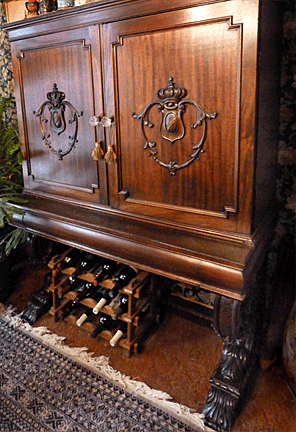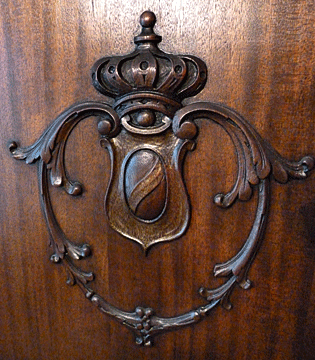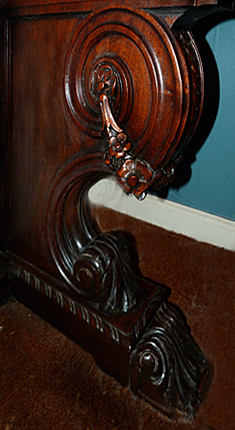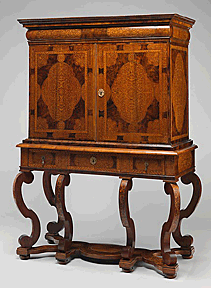|
Beauty From a Snowbank
by Bob Brooke
 This
is the story of how I acquired my very first piece of antique furniture.
Up until I discovered this piece, I had admired antiques but couldn’t
afford them. . This
is the story of how I acquired my very first piece of antique furniture.
Up until I discovered this piece, I had admired antiques but couldn’t
afford them. .
Even back in the early 1980s, antiques were still a commodity owned by
the wealthy—at least that’s what I thought. I had only seen fine pieces
in my rich uncle’s home when I was a young boy. When my family went to
visit him over the Christmas holidays, I was told to look but don’t
touch. So I figured antiques were something to be valued. They were
nothing like the hand-me-downs I had grown used to in my childhood.
After graduating from college, I got married and lived in a home with
more or less contemporary furniture. I still thought antiques were
something that only the wealthy could afford to own. What I didn’t
realize was that during the 1970s a sort of antiques revolution had
begun to take place. Pieces of Victorian Era furniture had started to
appear on the market. To the higher-end antique dealers, these were no
more than pieces of used furniture, for they only considered ones that
had been made before the Industrial Revolution began with the invention
of the steam engine in the 1830s.
 After
graduating from college, I got married and lived in a home with more or
less contemporary furniture. I still thought antiques were something
that only the wealthy could afford to own. What I didn’t realize was
that during the 1970s a sort of antiques revolution had begun to take
place. Pieces of Victorian Era furniture had started to appear on the
market. To the higher-end antique dealers, this was no more than used
furniture, for they only considered pieces that had been made before the
Industrial Revolution began with the invention of the steam engine in
the 1830s. After
graduating from college, I got married and lived in a home with more or
less contemporary furniture. I still thought antiques were something
that only the wealthy could afford to own. What I didn’t realize was
that during the 1970s a sort of antiques revolution had begun to take
place. Pieces of Victorian Era furniture had started to appear on the
market. To the higher-end antique dealers, this was no more than used
furniture, for they only considered pieces that had been made before the
Industrial Revolution began with the invention of the steam engine in
the 1830s.
My marriage wasn’t going anywhere. It was then that I met another person
in the same sort of situation. He liked old things and knew a lot about
these “newer” antiques. Both he and I were in the process of getting
divorced from our wives and decided to move in together. But neither of
us had much money to furnish an apartment. It was he who taught me how
to be resourceful and to look at pieces of Victorian furniture with a
eye to fixing them up and using them.
We began by searching used furniture and thrift shops for pieces we
needed. Even though the antiques shops nearby had pieces we liked, we
still couldn’t afford them.
One day, after we had been snowed in for a time, we took a ride around
the neighborhood. Snow had been piled high on both sides of the streets.
As we drove along, I noticed something sticking out of a snow bank. It
seemed to be a dark board with a carved crest on it. “Slow down,” I
yelled. As we did, I noticed another dark board with the same carving.
We stopped to investigate.
 As
we were pulling some of the pieces out of the snow, a short older woman
with wire-rimmed glasses came out of the antique shop in front of which
the snow bank and its half-buried treasure stood. “You can have those
pieces as long as you take these,” she said in a commanding voice as she
disappeared back into the shop. A few minutes later, she appeared with a
beautifully carved leg with lavish acanthus leaves, then ran back in.
Again she appeared with another matching dolphin. She went back in two
more times and came out with assorted pieces. As
we were pulling some of the pieces out of the snow, a short older woman
with wire-rimmed glasses came out of the antique shop in front of which
the snow bank and its half-buried treasure stood. “You can have those
pieces as long as you take these,” she said in a commanding voice as she
disappeared back into the shop. A few minutes later, she appeared with a
beautifully carved leg with lavish acanthus leaves, then ran back in.
Again she appeared with another matching dolphin. She went back in two
more times and came out with assorted pieces.
My friend and I loaded all the pieces into his car, and we drove back to
our apartment.
After unloading all the pieces, we sat there and stared at them. What
could this be? We didn’t have a clue as to how all the pieces fit
together. I went about some work I had to do and left him to fiddle with
the pieces.
Three hours later, he had somehow figured how a few of the pieces fit
together. And after a couple more hours, an unusual cabinet began to
emerge from the pile of wood. My interest peaked, and I joined him in
assembling this three-dimensional puzzle. Soon a magnificent piece of
furniture began to appear.
What we had found and rescued—though we didn’t know it at the time—was a
Renaissance Revival cabinet-on-stand, made to hold pieces of silver and
silver plate, of which we had neither. The interesting thing was that
the cabinet didn’t seem to connect to the base but just rested on top of
it.
The base consisted of what looked like a desk with one long drawer, held
up by the beautiful carved legs with lavish acanthus leaves. This led us
to believe that we had found two unrelated pieces of furniture. So we
set the cabinet on the floor and used it as a server in our dining area.
We placed the bottom portion in the living area and used it as a desk.
It wasn’t until about three years later, when we were rearranging the
furniture in our living room, that we set the cabinet on top of what we
thought was a desk. That’s when we realized we had found a silver
cabinet. And the strange thing was that any silver I stored in the
cabinet from then on never tarnished.
 It
wasn’t until preparing this article that I discovered that the true name
of this piece, which I still treasure greatly, is a cabinet-on-stand. It
wasn’t until preparing this article that I discovered that the true name
of this piece, which I still treasure greatly, is a cabinet-on-stand.
Cabinet-on-stands were popular in the 17th century. Cabinetmakers
sometimes decorated them in lacquerwork or marquetry. In Renaissance
Europe cabinets often rested on chests and were lavishly decorated. A
silver cabinet traditionally held the domestic or ceremonial plate of a
European royal and aristocratic family.
During the Renaissance Revival period of the Victorian Era, running from
approximately 1855 to1875, someone or some company chose to combine the
cabinet-on-stand design from the Renaissance with the utility of a
silver cabinet. From my research, I’ve discovered that my
cabinet-on-stand is most likely European, perhaps from either The
Netherlands or Germany. The result is one of the most unique pieces of
antique furniture I own—and it didn’t cost me a cent.
<
Back to Antiques Extra! Archives Next Editorial >
|
